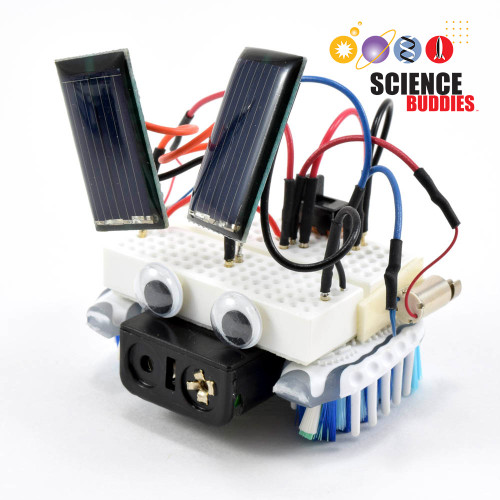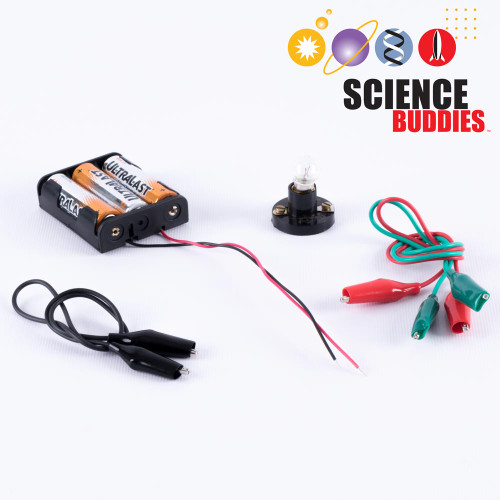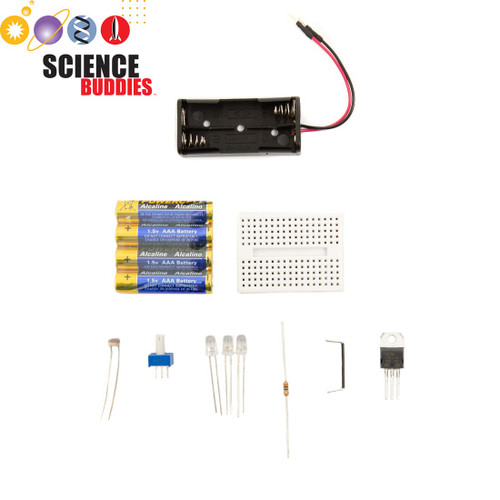Skip to Main Content


Veggie Power Battery Kit
Did you know you can produce electricity and make a battery from a potato? Use this Veggie Power Batter Kit to create your very own potato battery, and put different produce to the test to see which generates the most power! More Info
Ideal for Grades 4+
In Stock & Ready to Ship
Need it fast? See delivery options in cart.
Free Shipping on Most Orders $100+
- Create New Wish List
Product Description
What’s included, specifications, more details, science standards, videos & guides, shipping & returns.
- Economy Shipping is $7.95 for most orders (some products are not eligible ).
- FREE Economy Shipping on orders $100+ with code 100FREESHIP .
- Orders with 1-day or 2-day shipping placed by 1:00 pm MST ship the same day. All other orders typically ship the next business day.
- See Shipping Information for more details.
- Returns: Return unused products within 60 days. To get started, see our return policy .
Did you know you can produce electricity and make a battery from a potato? Use this Veggie Power Batter Kit to create your very own potato battery, and put different produce to the test to see which generates the most power! More Info
DESCRIPTION
Complete multiple science experiments with this hands-on Veggie Power Battery Kit!
With this battery science kit, elementary (Grades 4+), middle, and high school students can build and explore two different types of batteries:
- A saltwater battery
- A simple battery using potatoes (or other produce of your choice)
There is no better way to learn how batteries work than by building one yourself! Online Science Buddies project instructions guide you through the building , so you can quickly dive into the science fun and begin learning all about batteries, voltage, electrical current, resistance, energy sources, electrical circuits, and more!
While there are many different types of batteries, all rely on a chemical reaction of some kind to generate electricity.
In Science Buddies' words: "The chemical reaction typically occurs between two pieces of metal, called electrodes , and a liquid or paste, called an electrolyte . It turns out that the moisture inside a potato works pretty well as an electrolyte, so you just need to add some metal electrodes to a potato, and you have a battery.......Yes, you can actually use fruits and vegetables as part of an electric power source!"
Making a veggie and fruit battery is possible, and it works! Pretty amazing, isn't it?
This Veggie Power Battery Kit is designed for DIY science projects, with:
- reusable electronic components that allow you to conduct multiple science experiments and/or build two different kinds of batteries
- oversized electrodes that maximize the amount of current generated by your battery, so you can easily compare results from each of your tests
- a quality multimeter so you can get accurate measurements of the power output produced by your battery
- new and improved instructions feature lots of images to guide you step-by-step through the building of the battery and how to capture readings using the multimeter included in the veggie power battery kit
We make it easy for you to get started, but what you decide to explore is up to you. Which produce makes the most power? How much power is created when the batteries are connected in series or in parallel? The possibilities are endless!
This kit is compatible with a number of different projects from Science Buddies. Please see our list of projects and instructions .
MORE INFORMATION BOX
Instructions are NOT included with the kit, but are available online from Science Buddies.

If you have questions about your kit, please see the following FAQ article from Science Buddies:
- Veggie Power Kit FAQ
CONTENTS TAB
Each Veggie Power kit contains:
- 3 Copper electrodes
- 3 Zinc electrodes
- 6 Alligator clip leads
- 1 Digital multimeter with test leads
- 1 Piezoelectric buzzer
- 3 Super bright, high-efficiency red LED
- 1 1K ohm Resistor
SPECIFICATIONS TAB
You Might Also Like

Combining flavor, fun & chemistry, this spherification kit is a great & tasty intro to food science! Use food-grade versions of three chemicals used in molecular gastronomy recipes to create colorful, edible spheres!
View Details
Ideal for Grades 6+
Need It Fast? See Delivery Options In Cart.

Build 3 different kinds of wiggling, wobbling robots for a fun introduction to robotics. Cups, brushes, markers & googly eyes are not included in this kit. Use the fun design ideas shown to inspire your own creations!
Ideal for Grades K+

The Sugar Metabolism Kit provides a hands-on introduction to biochemistry and the nutritional impact of sugars. Recreate the chemical processes the human body uses to metabolize sugar and explore the link between sugars and serious health problems.

Have you ever taken a refreshing bath using a fizzing bath bomb? Science made it possible! Discover acid-base reactions with this hands-on Bath Bomb Science Kit, and reward yourself with a fizzy bath afterwards.

Use special sculpting dough to make fun creations with light-up LED accents! Three playful projects inside this Electric Play Dough Kit provide easy-to-follow instructions to learn about simple, series & parallel circuits.

Take the next step in building bristlebots! Build a light-tracking or solar-powered toothbrush robot. Brushes & googly eyes are not included in this kit. Use the fun design ideas shown to inspire your own creations!

The Basic Circuits Kit brings a unique twist to learning about electricity. Build a simple circuit, create your own dimmer switch, learn about conductors & more! See the product description below for more information.

Build a solar-powered water desalination device with materials ready for assembly! Based on an award-winning state science fair project, this engaging science kit is sure to provide hours of fun and experimentation.

With this physics science kit, you will make an electromagnet and investigate how the strength of its magnetic field changes with its design.

Night-lights can be found in many homes, even yours! Build your own night-light or lantern with this fun engineering project. The circuit you build using this kit is just like what you'd find in a night-light at the store.
Ideal for Grades 2+
We get it. Science can be messy. But Home Science Tools' products and service can handle it.
Our products are durable, reliable, and affordable to take you from the field to the lab to the kitchen. They won't let you down, no matter what they're up against. Whether it's (over)eager young scientists year after year, or rigorous requirements that come once-in-a lifetime.
And if your science inquiry doesn't go as expected, you can expect our customer service team to help. Count on friendly voices at the other end of the phone and expert advice in your inbox. They're not happy until you are.
Bottom line? We guarantee our products and service won't mess up your science study—no matter how messy it gets.
Questions? Get in touch with our Customer Service team.
- PRO Courses Guides New Tech Help Pro Expert Videos About wikiHow Pro Upgrade Sign In
- EDIT Edit this Article
- EXPLORE Tech Help Pro About Us Random Article Quizzes Request a New Article Community Dashboard This Or That Game Forums Popular Categories Arts and Entertainment Artwork Books Movies Computers and Electronics Computers Phone Skills Technology Hacks Health Men's Health Mental Health Women's Health Relationships Dating Love Relationship Issues Hobbies and Crafts Crafts Drawing Games Education & Communication Communication Skills Personal Development Studying Personal Care and Style Fashion Hair Care Personal Hygiene Youth Personal Care School Stuff Dating All Categories Arts and Entertainment Finance and Business Home and Garden Relationship Quizzes Cars & Other Vehicles Food and Entertaining Personal Care and Style Sports and Fitness Computers and Electronics Health Pets and Animals Travel Education & Communication Hobbies and Crafts Philosophy and Religion Work World Family Life Holidays and Traditions Relationships Youth
- Browse Articles
- Learn Something New
- Quizzes Hot
- Happiness Hub
- This Or That Game
- Train Your Brain
- Explore More
- Support wikiHow
- About wikiHow
- Log in / Sign up
- Education and Communications
- Science Experiments
- Junior Science Experiments
How to Create a Potato Battery
Last Updated: August 25, 2024 Fact Checked
This article was co-authored by Jessie Antonellis-John . Jessie Antonellis-John is a Math and Science Instructor who teaches at Southwestern Oregon Community College. With over 10 years of experience, she specializes in curriculum development. Jessie earned her PhD in Teaching & Teacher Education from the University of Arizona, her Master of Education from Western Governors University, and her BS in Astrophysics from Mount Holyoke College. She’s also co-authored several peer-reviewed journal articles in professional publications. There are 9 references cited in this article, which can be found at the bottom of the page. This article has been fact-checked, ensuring the accuracy of any cited facts and confirming the authority of its sources. This article has been viewed 550,371 times.
Did you ever think that you could use a vegetable as a battery? Batteries produce electricity by passing electrons back and forth between two metal plates What if you didn’t have a battery around, but had a potato? Well, potatoes contain phosphoric acid which can serve as the chemical solution necessary to transfer electrons back and forth between the metal plates. [1] X Research source By adding some metal to a potato, you can make a battery using just a few household items! Let's get started!
Making a Potato Battery

- Galvanized nails are standard nails that have a zinc coating. [2] X Research source They can be purchased at any hardware or home improvement store.
- Use a fresh potato as the experiment depends upon the juices inside the potato. [3] X Trustworthy Source Science Buddies Expert-sourced database of science projects, explanations, and educational material Go to source
- Some juice will come out of the potato during this step, but that’s okay.
- Cover your work surface with plastic or newspaper to avoid getting potato juice everywhere.
- If the nails do end up touching, simply reposition them so they are no longer touching.
- The distance between the nails does not need to be exactly one inch, but you want them to be close together.
- Some voltmeters have black and yellow leads instead of black and red. In this case, use the yellow lead for this step.
- Make sure the alligator clip is securely attached to both the nail and the lead.
- If the voltage is very low, try moving the nails closer together. Again, make sure they are not touching within the potato.
Powering a Clock with Multiple Potato Batteries

- Galvanized nails are regular nails that have a zinc coating that is necessary for this experiment. They can be found at a standard hardware or home improvement store.
- Copper coins, if needed, can also be found at a standard hardware or home improvement store.
- It doesn’t matter what color your alligator clip leads are as long as they have clips on both ends.
- Use firm and fresh potatoes. The liquid in the potatoes is necessary for this experiment, so dried out potatoes will not work. [9] X Research source
- Remove the battery from the clock before you begin.
- Some potato juice may leak out while doing this, but it will not affect the experiment.
- To make cleanup easier at the end, cover your work surface with newspaper or a plastic bag.
- At this point, each potato should have one galvanized nail and one copper coin inserted about an inch apart from each other.
- The exact distance between the nails is not important, you just want them to be close together without touching.
- Finishing this step, the two potatoes should be attached to each other and the clock.
- Check to make sure that all of your clips are securely attached.

- Make sure the clip is securely attached to the nail and the battery box.
- This makes the first connection in the circuit for the battery.

- Again, make sure to clip the leads on securely.
- At this point, each potato should be connected to the clock, but not to each other. One wire should be attached to the copper coin on one potato and a second wire should be attached to the galvanized nail on the second potato.
- If it still isn’t working, try reversing the leads.
- Make sure you are also using fresh potatoes.
- When you’re finished, remove the leads connecting the potatoes and reinstall the battery into the clock.
Community Q&A
- You can also try this with other fruits and vegetables, like lemons . Thanks Helpful 0 Not Helpful 1

- Young children should be supervised when performing this experiment. Nails and wires can be sharp if handled incorrectly. Thanks Helpful 4 Not Helpful 3

Things You'll Need
- Two galvanized nails
- Two copper coins/wires
- Two potatoes
- Three alligator clip leads
- Working Clock
You Might Also Like

Expert Interview

Thanks for reading our article! If you’d like to learn more about science, check out our in-depth interview with Jessie Antonellis-John .
- ↑ https://www.doitpoms.ac.uk/tlplib/batteries/potato_battery.php
- ↑ https://stemgeneration.org/potato-power/
- ↑ https://www.sciencebuddies.org/science-fair-projects/project-ideas/Energy_p010/energy-power/potato-battery#materials
- ↑ https://www.teachengineering.org/activities/view/cub_energy2_lesson04_activity2
- ↑ https://www.sciencebuddies.org/science-fair-projects/project-ideas/Energy_p010/energy-power/potato-battery#procedure
- ↑ https://www.scienceprojects.org/potato-battery/
- ↑ https://www.oregon.gov/energy/resources/Documents/Potato-Battery.pdf
- Videos provided by ExpCaseros
About This Article

To create a potato battery, start by inserting a galvanized nail near the middle of the potato and pushing it in until it's almost to the other side. Next, insert a copper coin halfway into the potato about 1 inch away from the nail. Make sure the nail and coin aren't touching each other! Then, using the end clips of a voltmeter, attach one clip to the nail and the other to the penny. You'll see a small increase in voltage on the voltmeter -- you just created a single-cell battery! For more tips, including how to use multiple potatoes for a stronger battery, read on! Did this summary help you? Yes No
- Send fan mail to authors
Reader Success Stories
Kori Florence
Mar 11, 2017
Did this article help you?
Mar 29, 2017
Nov 21, 2022
Jan 14, 2018
Featured Articles

Trending Articles

Watch Articles

- Terms of Use
- Privacy Policy
- Do Not Sell or Share My Info
- Not Selling Info
wikiHow Tech Help Pro:
Level up your tech skills and stay ahead of the curve

IMAGES
VIDEO